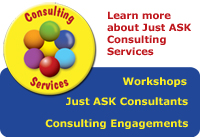
Volume IV Issue VI
Share this newsletter on
Stop!…In The Name of Learning

Bruce facilitating a Leading the Learning® workshop
Too often, because of the hectic life we lead, we operate on automatic pilot and rely on past practices without truly thinking about why we are doing what we do. We do not ask ourselves often enough if our actions contribute to student learning. Recently I have taken the time to think about some common, and perhaps not so common, practices that need to be examined more closely.
As I reflected on the lesson components below, I concluded that we need to take a second look at these practices and identify alternative practices that might lead to greater student engagement and learning. In my analysis of these practices, I offer alternatives for educators to consider. I hope that these thoughts will result in discussions, debates, and most importantly, deliberate decisions that better support student learning.
STOP… planning one-size-fits-all lessons and units. When teachers plan lessons and units that require all students to do the same thing at the same time using the same materials, it should not come as a surprise that some students struggle or are completely lost and unsuccessful, while others complete the lesson quickly and then appear to be bored or disengaged.
Instead… make differentiation of instruction a regular part of planning lessons and units. Begin by gathering pre-assessment data to learn what students already know about future content. Using pre-assessment data, complete a task analysis to determine what prerequisite knowledge and/or skills are necessary for students to be successful in the upcoming unit. The task analysis enables teachers to determine how best to meet the needs of the entire class or sub-groups within the class. The data obtained from the pre-assessment helps the teacher know which individuals will require one-on-one instruction using varied materials and teaching approaches.
STOP… sending students who do not bring books or supplies out of class. I have seen students sitting alone outside a room or sitting quietly in the main office of a school building with nothing to do. When I ask them why they are there, they offer a variety of excuses including that they forgot their homework, they did not have a pencil, or they left their book in their locker. When a student is excluded from the classroom, one thing is for sure: No learning is occurring!
Instead… provide the students the necessary materials. Some principals simply will not allow students to sit outside classrooms or to be sent to the office for not bringing supplies to class. They provide teachers with additional supplies (pencils and paper) as well as additional copies of books students can use when they forget their own. Some students forget materials on purpose because it will “opt them out” of the day’s learning activities. Teachers sometimes argue that when we provide materials for students, we are not teaching them to be responsible. On the other hand, when we send students out of class, they are “getting off easy” because they do not have to complete the same work as the other students.
STOP… having students read without a purpose. When teachers give students a reading assignment without setting a purpose for the reading, very little is occurring cognitively and the content of the reading is not registering with the student. Often students simply stare at the page to while away the time. They rarely remember what they have read and are not prepared to discuss the content of the reading with any personal connection or investment in the substance of the reading.
Instead… make sure that students are reading with a specific purpose in mind. Strong teachers preview the reading for the students and point out specific areas of the reading that are the most important. Teachers should employ techniques such as an Anticipation Reaction Guide or a Word Splash as described in Paula Rutherford’s book, Why Didn’t I Learn This in College? that help the students read more purposefully. Providing relevant questions that accompany reading assignments helps students make connections to their own lives.
STOP… requiring students to copy notes. Time is the most important currency teachers have with their students. When time is spent having students copy from an overhead or copy notes into a notebook, it is not a good use of time. When I asked students doing such an assignment what they were copying, they could not tell me. They were simply transcribing words from a source to a piece of paper.
Instead… provide a template for the students to fill in as they are processing information. Provide students notes on which they can write their own ideas or summaries at various points during the presentation. Space should be provided on the notes for students to fill in their own thoughts and make their own connections to the content under study.
STOP… lecturing while using an overhead or a PowerPoint presentation. As educators, many of us have attended in-services during which a presenter will project a series of overheads or use a PowerPoint as part of a lecture or presentation. As each new slide is projected, our attention moves to the information on the slide. When the presenter discusses the information on the slide, our attention is diverted to the visual stimuli and we are either reading the words on the slide or busy copying down the slide’s content in our notes. We are not, however, able to listen to the presenter and copy from the slide at the same time. Many teachers who use projection devices fall into the habit of talking about a slide’s content or elaborating on the ideas which they are visually presenting.
Instead… provide copies of the overheads for each student. Have the students focus on the visual or on the words but not both simultaneously. After a brief lecture, the teacher can ask students to review the handout and summarize in their own words their understanding of the ideas that are contained in both the teacher’s words as well as the handout. The teacher may also ask students to have brief paired or group discussions that require them to process the lesson content.
STOP… limiting checks for understanding to fact-based questions or recitations. When teachers conduct class discussions or include checks for understandings in their lessons, the types of questions they pose to students are generally ones which have a right or wrong answer. These questions require students to recall lesson content but may not require rigorous thinking.
Instead… carefully craft questions which require students to demonstrate their understanding of the lesson content at varying degrees of complexity. Questions should not be limited to one or two word answers but instead should require students to infer, interpret, analyze, or evaluate lesson content. In short, a teacher should challenge students at all levels on Bloom’s Taxonomy and not limit checks for understanding exclusively to the recall and comprehension levels.
STOP… summarizing the lesson content for students. Some educators wrap up lessons by saying something like, “Okay, let me summarize what we have learned today.” In the minds of students, this means that a transition is going to take place and they begin to prepare mentally and physically for the end of class. While the teacher is pulling together the lesson content, students are not paying attention and thus, the teacher’s summary is not accomplishing the necessary purpose.
Instead… develop a repertoire of summarizing techniques that require the students to summarize their own learning. When students grapple with lesson content and determine what they do or do not understand, they are able to self-assess their own learning. Also provide multiple opportunities for students to process and summarize learning during lessons.
STOP… assigning complicated at-home projects. Teachers can be very creative as they design projects they wish students to complete. In a recent classroom observation, I saw a teacher present requirements for an at-home project that was clever, creative, and supported the essential understandings of the unit. However, as I looked across the class of very diverse students, I wondered whether all of them had the necessary language skills, the necessary home support to complete such a project, or the funds to purchase the materials required for the assignment.
Instead… ask whether or not the project is a worthwhile use of student time, if the project reinforces the learning that represents the essential understandings of the unit, and if all students have access to success. A second question to ask is: If the project is worth doing, can it be done in class so all students have a “level playing field?” Some students thrive on projects because they have the skills, materials, and creativity to produce outstanding work plus they can rely on help from parents or other adults in their lives. Others may not have access to the same support.
STOP… giving students only one opportunity to demonstrate their learning. Many educators prepare summative assessments at the end of a unit, administer the assessment to students, determine and record individual student grades, and then move on to the next unit.
Instead… provide students feedback on their first efforts, give them opportunities to use the feedback to take corrective actions, and then the opportunity to be assessed a second time. If reteaching is required, the teacher can use data from the first round of assessments to adjust instruction. If a teacher’s job is truly to teach, allowing students only one chance to show what they have learned should be viewed as an archaic and outdated practice.
STOP… taking too long to return student work. There is no doubt that the life of a teacher is arduous and sometimes overwhelming. An important responsibility of teaching is to provide timely feedback to students on the work they do. When teachers collect multiple assignments without giving adequate feedback to students, the students do not know whether the work they have done is well done, merely acceptable, or in need of improvement. By the time some work is returned, students can barely remember completing the assignment.
Instead… plan ahead and determine which student work must be evaluated. Space out assignments in order to ensure that reviewing and critiquing can be done in a timely manner. Provide feedback to students so that each student knows what next steps he or she must take to improve work on the next assignment. Too often teachers feel that they must grade every assignment a student completes. As a result, well-intentioned educators become overwhelmed with the volume of paper work they must grade. Some teachers address the problem of paper work by setting up classroom structures so that students discuss work that they do and give feedback to one another. Still other teachers plan a series of shorter, formative assessments that do not require an overwhelming amount of time to evaluate.
If we want students to succeed, it is essential that we employ instructional practices that result in the greatest student learning. It is important for school administrators to think about the practices they observe teachers using and to ask themselves: Is this practice truly contributing to student learning? It is also important for leaders to bring certain practices to the attention of teachers and to promote discussions which help teachers eliminate ineffective practices, make adjustments to existing approaches, and add new ways of thinking to their repertoires in order to increase overall student achievement.
Permission is granted for reprinting and distribution of this newsletter for non-commercial use only. Please include the following citation on all copies:
Oliver, Bruce. “Stop!…In The Name of Learning.” Just for the ASKing! June 2007. Reproduced with permission of Just ASK Publications & Professional Development (Just ASK). © 2007 Just ASK. All rights reserved. Available at www.justaskpublications.com.



